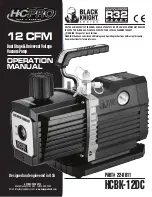
Page 20
System Operation
UNIT COMPONENTS
IMPORTANT
Some scroll compressors have an internal vacuum
protector that will unload scrolls when suction pressure
goes below 20 psig. A hissing sound will be heard when
the compressor is running unloaded. Protector will
reset when low pressure in system rises above 40 psig.
DO NOT REPLACE COMPRESSOR.
The outdoor unit and indoor blower cycle on demand from
the room thermostat. If the thermostat blower switch is in
the
ON
position, the indoor blower operates continuously.
Bi-Flow Liquid line Filter Drier
The unit is equipped with a large-capacity bi-flow filter dri
-
er which keeps the system clean and dry. If replacement is
necessary, order another of the same design and capac-
ity. The replacement filter drier must be suitable for use
with HFC-410A refrigerant.
Low Pressure Switch (S87)
The EL16XP1 is equipped with an auto-reset low pressure
switch which is located on the vapor line. The switch shuts
off the compressor when the vapor pressure falls below
the factory setting. This switch, which is ignored during
defrost operation, closes at pressures at or above 40 + 5
psig (276 + 34 kPa) and opens at 25 + 5 psig (172 + 34
kPa). It is not adjustable.
Low Pressure Switch Bypass (S41) (Optional)
For use in applications where the heat pump is operated
in outdoor ambient temperatures below 15°F.
• Prevents nuisance trips form the low pressure switch
• Wired in parallel with the low pressure switch
High Pressure Switch (S4)
The EL16XP1 is equipped with an auto-reset high pres
-
sure switch (single-pole, single-throw) which is located on
the liquid line. The switch shuts off the compressor when
discharge pressure rises above the factory setting. The
switch is normally closed and is permanently adjusted to
trip (open) at 590 + 15 psig (4068 + 103 kPa).
NOTE
–
A Schrader core is under the pressure switches.
Defrost Thermostat (S6)
The defrost thermostat is located on the liquid line be-
tween the check/expansion valve and the distributor.
When defrost thermostat senses 42°F (5.5°C) or cooler,
the thermostat contacts close and send a signal to the
defrost control to start the defrost timing. It also terminates
defrost when the liquid line warms up to 70°F (21°C).
Crankcase Heater (HR1) and Thermostat Switch (S40)
All models sizes are equipped with a belly band type
crankcase heater. HR1 prevents liquid from accumulating
in the compressor. The HR1 is controlled by a single pole,
single throw thermostat switch (S40) located on the liquid
line. On all units, the heater is on when there is no com-
pressor operation.
Thermal Protection Switch (S173) – Compressor
Mounted
Some EL16XP1 units are equipped with a compressor
mounted normally closed temperature switch that pre-
vents compressor damage due to overheating caused
by internal friction. The switch is located on top of the
compressor casing (see figure 1). This switch senses
the compressor casing temperature and opens at 239-
257°F (115°C-125°C) to shut off compressor operation.
The auto-reset switch closes when the compressor cas-
ing temperature falls to 151-187°F (66°C-86°C), and the
compressor is re-energized. This single-pole, single-throw
(SPST) bi-metallic switch is wired in series with the 24V Y
input signal to control compressor operation.
System Configuration
Demand Defrost Control (A108)
The demand defrost control measures differential tem
-
peratures to detect when the system is performing poorly
because of ice build-up on the outdoor coil. The control
self-calibrates
when the defrost system starts and after
each system defrost cycle. The demand defrost control
components are shown in figure 12.
•
Demand defrost control connections, jumpers and LED
locations are shown in figure 12.
•
Demand defrost control connections, jumpers and LED
descriptions are listed on table 3.
•
Demand defrost control status, fault and lockout LEDs
are listed in table 4.











































